With the rapid emergence of IoT, wearables, automotive electronics, and various smart mobile devices, companies are keen to pursue innovations and to create something truly disruptive. In order to help customers embrace the latest technology trends and to develop differentiated products, Imagination recently held its annual Imagination Summit in Taipei and Hsinchu. With more than one thousand registered attendees and 600 people visiting the events, Imagination has set a record number of attendance since it held the first Hsinchu Summit in 2012.
Imagination Summits are day-long events featuring visionary keynotes, technical deep dives and interactive sessions with experts from Imagination and its partners. This year's Summits in Taiwan feature keynotes from MediaTek, the prpl Foundation, Realtek and TSMC, as well as presentations and demonstrations from Imagination and partners including M31, Mentor Graphics and Synopsys.
Maxwell Lin, Sales Director of Imagination Taiwan, said at opening remarks, "As market evolves, it's no longer feasible to follow the traditional way to design by simply selecting technical solutions with the highest CP value from PPA comparison. In an effort to develop more competitive products, companies need to have breakthrough thinking, address the security mechanism required by new services, and carefully handle the system integration issues. Thus, under this year's Summit banner "Secure. Integrate. Differentiate", we'll showcase comprehensive design solutions to help companies reach this goal."
New Thinking for the Next Wave of Innovation
Tony King-Smith, EVP marketing of Imagination disclosed the latest development trend of semiconductor industry at the keynote speech. As a leading provider of SoC IP, Imagination not only has in-depth understanding and insights for a wide range of markets, including mobile phone, automobile, networking, enterprise, IoT, and consumer entertainment, but also needs to be able to see the trends for next 5 to 10 years, so that it can take the lead to develop new technologies for future SoCs.
As consumer electronics technologies are penetrating into enterprise market and powering everything, everywhere, Tony King-Smith believes that these low-power, high performance technologies will bring profound influences to drive all kinds of applications. Computer vision, security, virtual reality (VR) & augmented reality (AR), connectivity, and application portability will be the major trends in the future.
Mega Societal Changes Underway
On the other hand, the world that we live in is changing rapidly and dramatically. With the arrival of the emerging world, which includes the most populous countries like China, India, and Brazil, ever more middle-class is rising but also more price competitions. However, in the connected and accessible world, one global market is also forming. Also, the accelerating technological possibilities in many fields, such as IoT, robotics/automation, biomedical, will also change the landscape of hi-tech industry. It is believed that, in the future, the tier-one leading companies will be much different than what we have today.
Meanwhile, facing the challenges of global warming, we need to use energy more efficiently, and low-power design will become increasingly important with the widespread usage of IoT and wearable devices. And the era of Industry 4.0 will lead to manufacturing returning to local markets in many sectors, which eventually will transform the existing supply chain. Finally, the advent of aging society, 100+ year human life spans will definitely change demographics. But it is clear that today's infrastructure can't cope with tomorrow's population's needs.
Driven by these technical and market trends, the industrial chain is also evolving. As OEMs are seeking for innovation, the importance of IP is getting much higher. IP vendors should focus on the development of key function blocks, and through close collaboration, helping OEMs pursue for differentiation designs. In addition, as more and more consumers switch to online purchasing, the influential factors for buy decisions are also changed.
The semiconductor world is changing, too. With the on-going consolidation and OEMs' vertical integration, product development will become more "application-driven". Under this trend, there will be four types of semiconductor players in the future. Among them, two are tradition chip vendors. One is the super-high volume SoC providers supporting large mainstream segments like mobile, and the other is specialized players focusing on smaller and specialized applications such as auto, health, home automation, and industrial.
But another two types of new chip vendors will emerge, including the vertical major OEM brands with internal IC design team, such as Amazon and Apple, and the medium to large sized OEMs, which try to replicate vertical model but through partnership with other service providers and brands. In particular, in Taiwan, we will see lots of OEMs of this kind rising rapidly in the coming three to five years, and bring the next-wave of growth momentum.
Multi-Domain Security
To address the future market requirements, companies need new concepts and solutions. Tony King-Smith talked about what matters for new product development: security, platform solutions, and IoT technologies.
Every application has security demands, and it is fundamental to all connected devices, including IoT. But today's simplistic "binary in/out" model is no longer good enough to meet users and application needs. We need universal solutions to ensure security across every process elements in the SoC; therefore, multi-domain, system-wide security will become a must.
Current security solutions are CPU centric, which make secure applications all co-exist in one secure area. This is good for products that are defined in the factory and never change, but it can't scale to address the needs of operators and brands delivering portfolios of cloud-based services on open platforms.
OmniShield in a multi-domain, heterogeneous, scalable, and hardware-enforced security technology. Imagination is teaming up with prpl Foundation to promote truly open and heterogeneous security platform. Several companies, including Broadcom, Qualcomm, also joined to collaboratively create the next cross-industry security standard.
Making use of platform solutions
PowerVR GPU, MIPS CPU, and Ensigma RPU are the three pillars of Imagination's platform solutions. On the basis of this, we can help our customers leverage their know-how to develop SoCs for various applications including mobile, smart home, enterprise, IoT, connected cars, and so on.
For customers, integrating different IP blocks is a challenging job, and our mission is to integrate these major function blocks properly in advance, so that customer can focus on differentiating their products. Therefore, for the four types of semiconductor plays, our strategy is to align with and address their different needs by providing them with the comprehensive IP portfolio, reference platform, subsystem IP, and ecosystem supports, and all these IP products will be protected by our OmniShield security technology.
These pre-verified solutions can help companies enable the next wave of innovation. Not only SoC IP, software and tools are equally important. For example, strong software tools are one of the key factors to the success of PowerVR GPU. We will continue to take this strategy to expand ecosystems around our market-leading IPs. For example, we already partnered with Microchip, Samsung Artik, and Toshiba in our IoT ecosystem. In addition, we initiated FlowCloud and Creator programs to offer developers early access to new technologies from Imagination.
Turning IoT into Reality
IoT is the hottest topic today, and it will be a very large but fragmented market. The breadth of applications means no one player will dominate. Perhaps, some tier-one system companies will take "walled garden" strategy to develop smart home related products with their proprietary technologies and services. But for most of the companies that don't have the ability to construct entire services and product portfolios, interoperability is in urgent need. Therefore, service level interoperability and security will be the growth enablers, and ecosystems of many different skills will be essential to create solutions that really work.
Though IoT seems promising, it's still in very early stage. We have seen too much re-branding of existing technologies and products as IoT, but they are not really mature ones. At Imagination, we see there are three levels of IoT devices to address major societal issues: application-specific sensor hubs, sensor hubs + audio/voice, and sensor hubs + audio/voice + smart vision.
Our silicon IP portfolio addresses the needs of all of these key markets, including real-time, complex processing requirements for connected processor, smart camera, and audio. In order to realize the goal of IoT, as an industry, we need to work together to build truly open standards. IoT standardization focus should be on common connectivity standards, service-level interoperability via standardized protocols and APIs, and not tied to any OS, processor or other capabilities.
As for the wearables, it is also a hot new thing. Though some treat it as IoT, we consider it a distinct, separate market. The market will result in multiple segments, such as all-in-one, lifestyle-oriented, in-clothing, and so on. Therefore, wearable devices will vary in capabilities and feature requirements. Also, the future of wearables ad their relationship to mobile and connected home will be increasing profound and how they work together will be key.
However, in terms of functionality, user interface, and battery life, current generation of wearables are just smartphone functionality in a watch form factor. To succeed in the market, companies should shift focus from technology to wearability of the products, and address their specific requirements by adopting new SoC architecture. Low power, connectivity, security, user interface, and interoperability will be the five winning factors.
Imagination's MIPS CPU, PowerVR GPU, Ensigma RPU, FlowCloud cloud service, and OmniShield security technology can address what really matters to wearables and help our customers create innovation for success.
Home Gateway: Enabling Multi-Domain Security Revolution
According to Volker Politz, Vice President of Segment Marketing at Imagination, with fast changing consumer demands, home gateway is now in a big transition. Especially, in the cloud and IoT era, home gateway is increasingly important to allow operators to rapidly introduce new services for home surveillance, personal health, energy management, and smart home. But traditional design is no longer able to address these new market requirements.
Resiliency, scalability, protection, and service provisioning are the main design challenges for home gateway. For example, in addition to basic routing, switching and networking functions, the new-generation home gateway may be used to provide public Wi-Fi hotspot, or supports various IoT services at home enabled through Zigbee, Bluetooth, or 802.11n/ac standards.
These functions require different levels of security and priority. For this, Imagination introduced OmniShield security technology incorporating comprehensive portfolio of technologies, including hardware virtualized CPU, hardware virtualized GPU, secure fabric, trusted hypervisor, virtualized connectivity and offloads, and root of trust. It supports up to 255 secure heterogeneous containers on an SoC, which means that chip designers can partition its SoC into several secure domains based on application demands.
Virtualization is a mature and proven technology and has strong software supports. As a result, OmniShield can benefit from this feature to provide hardware firewall level of security and achieve the highest flexibility and performance. In the use case of home gateway, different functions such as broadband and IoT aggregation can be isolated in separate secure domains to ensure security and accelerate time to market.
On the other hand, for real-time applications, MIPS multi-thread technology can be used to enable real-time operation of trusted functions with almost zero performance penalty.
Total cost of ownership for home gateway will be reduced dramatically by using OmniShield and Imagination's IP and IP platforms, and to provide operators with secure, scalable, and reliable solutions.
PowerVR GPU IP from Wearables to Servers
"Embedded GPU has been mainly used in mobile phones and tables," Kristof Beets, Director of Business Development at Imagination, said. "As the demands for graphic function grows, it is gradually penetrated into set-up boxes, HD TV, automotive infotainment, and more."
The latest trend is to have GPU used in a wide range of applications, including IoT, wearables, enterprise, servers, and laptops. Thus, we can see huge range of opportunities for GPU, and also wide range of performance and feature requirements across markets.
For GPU market, the rapid evolution of industry standard APIs can further improve its performance, such as the latest Khronos Vulkan and Khronos OpenVX. Vulkan is a low-level "metal" API, and is not to replace existing OpenGL ES. By matching modern GPU architectures, it provides higher performance with less CPU overhead. OpenVX is high-level API for vision/image processing and fully GPU accelerated. PowerVR GPU will support this new API in H2 2015.
Also, due to the increasing fragmentation of the OS landscape, GPU should be able to support wider range of OSes, including Android, Ubuntu, FireOS, WebOS, and Chromium. Another key issue for GPU is that designers must carefully consider optimal system integration. For example, using lossless compression to support 4K tablets, or security and virtualization technology for automotive and server applications.
Because of the widespread applications of GPU, we need to provide comprehensive solutions to address both the cost-sensitive applications such digital TV, wearables, entry-level smartphones, or the performance-efficient applications such as high-end tables and automotive.
PowerVR is highly competitive and continues extending its market leadership. In terms of architectural performance, by using patented tile-based deferred rendering and PowerGearing power management technologies, PowerVR delivers high sustained performance within power budget. As for power efficiency, third-party data confirms that, compared with other solutions, SoC that is enabled by PowerVR can achieve 3 times better performance at the same power consumption. Imagination will keep improving the performance for each generation PowerVR to ensure better battery life and better user experience.
MIPS CPU: Differentiating the Next Wave of Innovation
"With comprehensive portfolio from the tiny 32-bit MCU to high performance 32- and 64-bit multi-core solutions, MIPS CPU is a proven, efficient 64/32-bit architecture, with more than 30 years of history and 20 years of full support to 64-bit technology," Mark Throndson, Director of MIPS Business Development at Imagination, introduced.
MIPS architecture has been updated for several times in past years, and the latest version is MIPS R6, which incorporates hardware virtualization, SIMD, multi-threading features. MIPS64 is fully compatible with MIPS32. Software runs on MIPS32 doesn't have to switch mode to run on MIPS64, which will bring significant benefits for customers.
Also, Imagination provides comprehensive tools for every aspect of development. Codescape tools, which are used for every MIPS-based platform development from entry-level to multi-core SoC, build on the open source GNU compiler and debugger (GCC and GDB) for MIPS, including all of the tools and resources needed to get started with MIPS software development, including bootloaders, linkers, example code, and more.
After acquiring MIPS, Imagination continues expanding it ecosystem. One of the key projects is to initiate prpl Foundation, which aims to drive the progress of application portability, virtualization and security, and heterogeneous computing based on MIPS open source.
MIPS CPU now supports OmniShield security technology. Based on hardware virtualization, a new privilege level is added in the architecture to support multiple guest domains and realize multi-domain security on CPU. From top to bottom core lineup, including M5100, I6400, and P5600, hardware virtualization is supported, and MIPS is the only company that implements virtualization for embedded MCU.
Moreover, MIPS' unique hardware multi-threading and advanced power management technologies can effectively reduce silicon area and optimize dynamic power. MIPS portfolio includes three product lines from entry-level to high performance, Warrior M-class, Warrior I-class, and Warrior P-class, to address various market requirements.
Ensigma RPU: The complete wireless solution
"Wireless connectivity has become a must for electronic devices, but most of them are designed by using stand-alone wireless chipset," Richard Edgar, Director of Communications Technology at Imagination, said. "In order to achieve higher level of integration, we have seen the trend of integrating wireless communication functions onto SoC. Ensigma RPU (radio processing unit) is designed for this requirement."
Ensigma RPU is a complete end-to-end solution and the only complete wireless IP subsystem in the market today. It includes integrated baseband and MAC, "hardened" RF IP, complete host software, and system solution for industry certification testing and RF regulatory testing.
Ensigma RPU is unique programmable multi-standard radio processor, supporting more than 30 standards including all 802.11, television, radio, and Bluetooth standards. New 802.11ax and 802.15.4 standards, and GPS and Galileo positioning standards are in development. It is expected that a total of 45 standards will be supported within two years.
With superior configurability, Ensigma RPU integrates multi-stand on-chip communication standards onto SoC. For different market segment, two product lines are provided. Ensigma Explorer is featured with ultimate performance and flexibility, and Ensigma Whisper is for ultra-low wireless. With integrated MIPS processor, Whisper removes need for dedicated host to reduce total system cost. It is ideal for emerging wearable devices.
Meanwhile, Explorer and Whisper have the same host interface and are based on the same core algorithms. So, software and development tools can be shared to further reduce development efforts and cost.
Other sessions in the afternoon included "Wearables: Low-power Design Meets High-power Fashion", "Automotive: Making Autonomous, Multimedia-rich Cars a Reality", "Vision IP: Powering the Smarter Camera", and "Connected Processors and FlowCloud IP: Integrating and Securing end-to-end IoT", showcasing the comprehensive solutions that Imagination provides for next-generation product development.
Partners Gathered to Show Great Support
In addition to the latest trends and technical solutions presented by Imagination's executives, major partners also participated the event to share their market insights as well as the results that they work with Imagination.
Siegmund Redl, VP & GM Corporate Marketing of MediaTek Europe explained the rise of the "super-mid" market opportunity resulted from the dramatic increase of middle-class population worldwide, and the brand new industry landscape caused by ubiquitous and unlimited access to information through 5G technology. Therefore, collaboration and joint development among ecosystem partners will become more important than ever before.
Keynes Chang, Marketing and Planning Director of Realtek discussed the future trend and requirement of GPU in TV SoC. "As display function gets increasingly important, area of GPU on a TV SoC is now bigger than that of CPU, and both of them account for more than one third of the total die size," he said.
GPU is mainly used for user interface. But with the higher resolution of multimedia devices, 3D GPU can bring much better user experience. TV will be able to run multiple high-resolution video games to replace certain functions of game console. In addition, TV will support more functions such as facial recognition and new formats of video decoding in the future.
As GPU plays an increasingly important role, new security issues rise. For example, the last thing that content providers would like to see is their premium 4K content is being hacked. Or, video clips will be used as user interface on new-generation products. In the past, there were no security issues for UI, but now the situation is changed because video is handled by GPU.
There are multiple ways to address security requirement for GPU. One is to use virtualization technology to have multiple isolated, secure zones on SoC. However, it requires complex memory management unit. Designers should take this account when developing SoC. He concluded that, the more powerful GPU is, the more important the content that it processes. GPU is no longer only a functional IP block, but an integral part of SoC. So its security requirement should be carefully addressed.
Simon Wang, Senior Director of IoT Business Development at TSMC, introduced the latest technical solutions for IoT. Though process node shrinkage has almost reached its limitation, advanced process technology is still required to drive the diverse and advanced applications for automotive, industry 4.0, and AR/VR, and to maintain the health growth of semiconductor industry.
IoT market will be taking off rapidly, but demands for advanced 16/10 nm will still exist. But it will change from performance-driven concept to low power-driven. In addition to advanced nodes, TSMC is developing low-power 55/40/28 nm process technologies to further reduce leakage and extend battery life.
TSMC will also strengthen cooperation with OIP (Open Innovation Platform) partners. TSMC and Imagination have built close and long relationship. Two companies will optimize GPU designs for 28/16 nm processes and provide verified IPs to help accelerate mutual customers' time to market.
Cesare Garlati, Chief Security Strategist of prpl Foundation, explored the importance of open standards with open security. Prpl Foundation is an open-source, community-driven, collaborative, non-profit foundation targeting and supporting the MIPS architecture-and open to others-with a focus on enabling next-generation datacenter-to-device portable software and virtualized architectures. To address security requirement, the foundation is now working with members to drive end-to-end system security.
In the afternoon's sessions, M31 Technology introduced its Power Optimization Solutions for IoT Application. Dolby showcased its Dolby Audio, which is a set of robust technologies that deliver rich, clear, powerful sound in the cinema, at home and on the go. Imagination supports Dolby Audio on MIPS CPU, including support for Dolby TrueHD, Digital Plus, and ProLogic IIz.
Mentor Graphics had two technical sessions. One is to discuss the use case of emulation of Imagination IP on Veloce platform. Veloce2 is a market-leading hardware emulator, addressing challenges for large complex SoC verification such as smartphones and ADAS, and Mentor has a long standing partnership with Imagination. The other session is to introduce Mentor's embedded software solutions for wearable Devices. Ineda's MIPS-based wearable process unit is used as an example to discuss how it works with Mentor's Nucleus RTOS.
Synopsys also had two sessions. In the "Collaborating to Speed Design and Verification with Optimized PPA" session, Synopsys stressed its more than 10 years of collaboration with Imagination, and can help customers shorten design cycle with its verification and prototyping solutions. Using HAPS-70 platform to accelerate hardware verification and software development for Imagination PowerVR Series 6XT was explained. The other session discussed "Hardening Imagination's 16FF+ PowerVR Series 7 GPU for Performance & Power with DesignWare HPC Design Kit". With these rich and informative speeches and sessions, the full-day technology feast was wrapped up with a perfect end.

Imagination recently held its annual Imagination Summits in Hsinchu and Taipei, with more than 1000 registered attendees and 600 people visiting the events.

Maxwell Lin, Director of Sales, Taiwan Imagination Technology
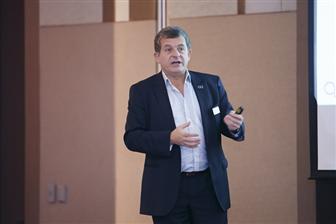
Tony King-Smith, EVP Marketing, Imagination Technology

Siegmund Redl VP & GM Corporate Marketing, Europe MediaTek

Keynes Chang, Marketing and Planning Director, Realtek
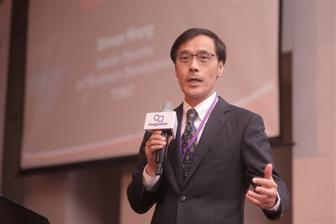
Simon Wang, Senior Director, IoT Business Development, TSMC

Cesare Garlati, Chief Security Strategist, prpl Foundation
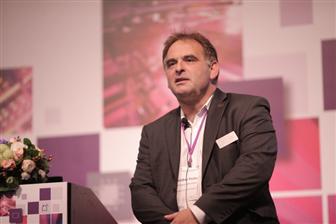
Volker Politz, VP Segment Marketing, Imagination Technology
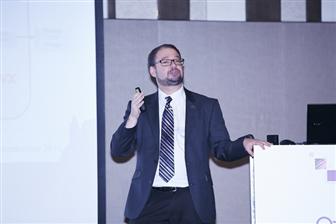
Kristof Beets, PowerVR Business Development, Imagination Technology
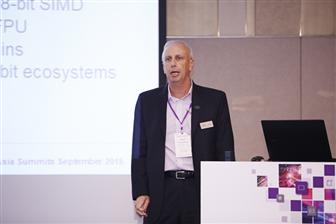
Mark Throndson, Director of Business Development - MIPS,
Imagination Technology
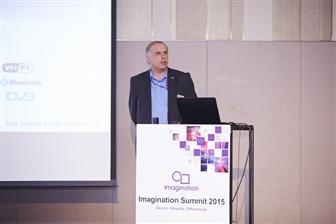
Richard Edgar Ensigma Communications Technology
Marketing, Imagination Technology

At 2015 Imagination Summit, Imagination and its partners showcased latest technical solutions, attracting attendees' warm interactions and discussions.

